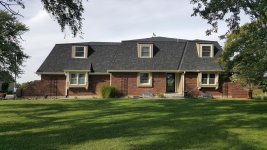In my experience, roofers are second only to foundation repair companies in how crooked they are. It's almost impossible to find an honest roofer, but in most cases, it takes a decade to realize where they cut corners.
Moisture in the attic is from not having enough air flow. With the constant changing of temperatures and humidity levels, the attic space develops condensation. The only way to remove that moisture is air flow. Heat rises. Air coming in from the soffits, warms up in the attic, and exits through the vents. A ridge vent gives you the most air flow if your soffit vents are open and allowing air to enter. In some homes, insulation will cover the soffit vents and the air flow is restricted. In some homes, there are only a couple of soffit vents. In new homes, the entire soffit is a vent with products from Hardie or Smart. You really cannot have enough air flow in an attic.
A valley in a roof is a very common place for a roof leak. In poorly done roofs, they just overlap the underlayment and then shingle over that. In better roofs, they install metal or Grace Weathershield. If this was not done correctly when the roof was installed, then you cannot patch it. Eventually the roof will have to come off and the valleys will have to be done properly. Next place for leaks are the vents, or anything else going through the roof. Bad roofers will re use the old vents and flashing. A new roof has to have all brand new flashing and vent covers. And last, the flashing along the side of the dormer has to be metal and there cannot be any nails through it where water will flow. The siding has to be above the shingles at least an inch, with 1 1/2 inches being better. It's ugly to most people to see that flashing, and not have the siding touch the shingles, but it's the only way to make sure it's water proof.
When talking to roofers, the first thing I ask is "how long are the nails that you will use?" Roofers will save a buck anywhere they can. some will use staples. Run away from those guys. Most use nails. They have to be 1 1/2 inches long or longer. The shaft of the nail has to go through the decking for it to hold. You have to see this when in the attic to know that the correct nails where used.
Some roofers will leave the old tar paper up when stripping the shingles. They do this to hide the issues with the decking. If nobody can see the damaged decking, they don't have to fix it. On older houses, 1x pine was used. It varies in size all over the house. It also has massive holes in it from knotholes, splintering and just falling apart into the attic space. Plywood is OK if it's in decent shape, but it tends to break apart when nailed. An inspection of the underside of the decking is very important before signing a contract with a roofer. I prefer OSB. It holds nails better then plywood because it doesn't blow out when nailed. But brand new, plywood and OSB are both going to hold nails about the same. Second roof is when OSB is far superior to plywood. Cost of materials also makes OSB more desirable.
Insist that all brand new flashing is installed around the edge of the roof. I get a lot of work fixing rotten soffits and fascia from new roofs that did not get any flashing installed. It's cheap and easy to install, but if a roofer can save a buck, he will!!!
Metal will last longer then asphalt shingles, but it's usually more difficult for most roofers to install. You need an experienced roofer with metal roofs to be sure it's done right. There are also a lot of options with metal roofs, from hidden fastener, to R panels to metal that looks like shingles. The price goes from comparable to shingles, to a lot more money for metal.


